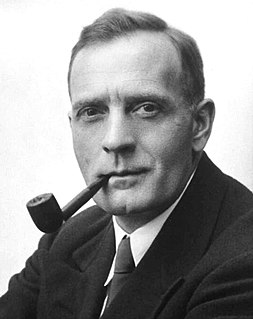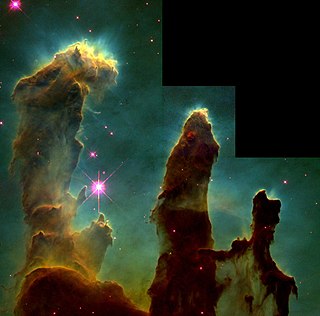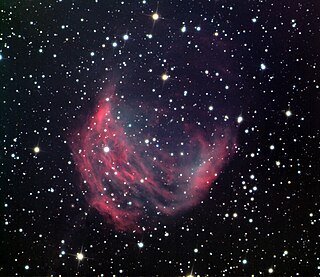See also
| Visible nebula | |
|---|---|
| Pre-stellar nebula | |
| Stellar nebula | |
| Post-stellar nebula | |
| Clouds | |
| Morphology | |
| |
|
This article includes an astronomy-related list of lists.
The following articles contain lists of nebulae :

Edwin Powell Hubble was an American astronomer. He played a crucial role in establishing the fields of extragalactic astronomy and observational cosmology.

A nebula is an interstellar cloud of dust, hydrogen, helium and other ionized gases. Originally, the term was used to describe any diffused astronomical object, including galaxies beyond the Milky Way. The Andromeda Galaxy, for instance, was once referred to as the Andromeda Nebula before the true nature of galaxies was confirmed in the early 20th century by Vesto Slipher, Edwin Hubble and others. Edwin Hubble discovered that most nebulae are associated by stars and illuminated by starlight. He also helped categorize nebulae based on the type of light spectra they produced.

A planetary nebula, is a type of emission nebula consisting of an expanding, glowing shell of ionized gas ejected from red giant stars late in their lives.

The New General Catalogue of Nebulae and Clusters of Stars is an astronomical catalogue of deep-sky objects compiled by John Louis Emil Dreyer in 1888. The NGC contains 7,840 objects, including galaxies, star clusters, emission nebulae and absorption nebulae. Dreyer published two supplements to the NGC in 1895 and 1908, known as the Index Catalogues, describing a further 5,386 astronomical objects. Thousands of these objects are best known by their NGC or IC numbers, which remain in widespread use.

A dark nebula or absorption nebula is a type of interstellar cloud that is so dense that it obscures the visible wavelengths of light from objects behind it, such as background stars and emission or reflection nebulae. The extinction of the light is caused by interstellar dust grains located in the coldest, densest parts of molecular clouds. Clusters and large complexes of dark nebulae are associated with Giant Molecular Clouds. Isolated small dark nebulae are called Bok globules. Like other interstellar dust or material, things it obscures are only visible using radio waves in radio astronomy or infrared in infrared astronomy.

An astronomical object or celestial object is a naturally occurring physical entity, association, or structure that exists in the observable universe. In astronomy, the terms object and body are often used interchangeably. However, an astronomical body or celestial body is a single, tightly bound, contiguous entity, while an astronomical or celestial object is a complex, less cohesively bound structure, which may consist of multiple bodies or even other objects with substructures.

The Eskimo Nebula, also known as the Clown-faced Nebula, Lion Nebula, or Caldwell 39, is a bipolar double-shell planetary nebula (PN). It was discovered by astronomer William Herschel in 1787. The formation resembles a person's head surrounded by a parka hood. It is surrounded by gas that composed the outer layers of a Sun-like star. The visible inner filaments are ejected by a strong wind of particles from the central star. The outer disk contains unusual, light-year-long filaments.

This is a list of lists, grouped by type of astronomical object.

The Horsehead Nebula is a small dark nebula in the constellation Orion. The nebula is located just to the south of Alnitak, the easternmost star of Orion's Belt, and is part of the much larger Orion Molecular Cloud Complex. It appears within the southern region of the dense dust cloud known as Lynds 1630, along the edge of the much larger, active star-forming H II region called IC 434.

A deep-sky object (DSO) is any astronomical object that is not an individual star or Solar System object. The classification is used for the most part by amateur astronomers to denote visually observed faint naked eye and telescopic objects such as star clusters, nebulae and galaxies. This distinction is practical and technical, implying a variety of instruments and techniques appropriate to observation, and does not distinguish the nature of the object itself.

The Lagoon Nebula is a giant interstellar cloud in the constellation Sagittarius. It is classified as an emission nebula and as an H II region.

NGC 2371-2 is a dual lobed planetary nebula located in the constellation Gemini. Visually, it appears like it could be two separate objects; therefore, two entries were given to the planetary nebula by John Louis Emil Dreyer in the New General Catalogue, so it may be referred to as NGC 2371, NGC 2372, or variations on this name.

The Sharpless catalog is a list of 313 H II regions intended to be comprehensive north of declination −27°. The first edition was published in 1953 with 142 objects (Sh1), and the second and final version was published by US astronomer Stewart Sharpless in 1959 with 312 objects. Sharpless also includes some planetary nebulae and supernova remnants, in addition to H II regions.

An astronomical catalog or catalogue is a list or tabulation of astronomical objects, typically grouped together because they share a common type, morphology, origin, means of detection, or method of discovery. The oldest and largest are star catalogues. Hundreds have been published, including general ones and special ones for such items as infrared stars, variable stars, giant stars, multiple star systems, star clusters, and so forth.

Kronberger 61, also known as the "soccer ball", is a planetary nebula discovered by an amateur astronomer in January, 2011, with the newer images having been taken by the Gemini Observatory. The nebula is named for Austrian Mattias Kronberger, who is a member of the amateur group Deep Sky Hunters. The object is estimated to lie 13,000 light-years away. They discovered the nebula while searching near the northern constellation of Cygnus. It is hoped that the discovery will help resolve a decades-old debate, regarding the role of stellar companions in the formation and structure of planetary nebulae.

The Abell Catalog of Planetary Nebulae was created in 1966 by George O. Abell and was composed of 86 entries thought to be planetary nebulae that were collected from discoveries, about half by Albert George Wilson and the rest by Abell, Robert George Harrington, and Rudolph Minkowski. All were discovered before August 1955 as part of the National Geographic Society – Palomar Observatory Sky Survey on photographic plates created with the 48-inch (1.2 m) Samuel Oschin telescope at Mount Palomar. Four are better known from previous catalogs: Abell 50 is NGC 6742, Abell 75 is NGC 7076, Abell 37 is IC 972, and Abell 81 is IC 1454. Another four were later rejected as not being planetaries: Abell 11, Abell 32, Abell 76, and Abell 85. Another three were also not included in the Strasbourg-ESO Catalogue of Galactic Planetary Nebulae (SEC): Abell 9, Abell 17, and Abell 64. Planetaries on the list are best viewed with a large aperture telescope and an OIII filter.